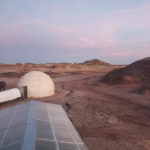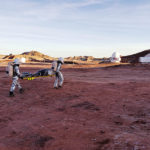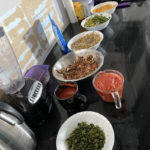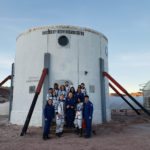Sol Summary – February 1st
Crew 220 (MDRS) Sol Summary 01Feb2020
Sol: 13
Summary Title: HabComm this is MDRS – Over
Author’s name: Connie Delisle, PhD
Mission Status: Nominal
Sol Activity Summary: The MDRS-MAU crews woke up at 08:00 and began for their Mars departure. The signature red sky gave reluctantly gave way to a light blue as the sun began to glow. The morning ritual of sky-gazing and sipping coffee will remain a cherished memory of Mars. The Crew was treated to a pancake breakfast by Crew Engineer Wise. Following the meal, Commander Hanacek delegated Crew members to station clean up – MDRS lower deck, upper deck, airlocks and stair, the RAM, and the Science Dome. We were fortunate that MAU Crew Engineer Roberts cleaned Spirit and Curiosity rovers – scrubbing off the red mud by hand. We really appreciated that he took this on knowing he had to depart for Earth later that day. The MAU Crew was joined by a few of the MDRS Crew members for the better part of the afternoon to take down the MAU Station which is a series of portable structures – airlock, living quarters, crew activity / meal, and cooking area. Due to cycles of Mars soil freezing and thawing, the station required a great deal of regular maintenance and engineering support. We are grateful we are resourceful! Marufa Bhuiyan, MSc. and International Astrology Researcher joined me in cleaning the upper deck. The arrival of a beautiful new gas stove was a highlight for me as I was preparing to make pizza with the herbs form the Green Hab for a late lunch. As part of a multi-tasking habit from Earth, I let lunch preparation sit and accompanied the MDRS Assistant Director on the check-out walk through. I am pleased to report that the Station is ship shape. The rest of the afternoon was focused on packing up the MAU station into the UHaul, writing reports and completing science research studies.
Look Ahead Plan: This evening activities includes finishing reports, briefing the incoming crew and going to town for shared meal. The entire MDRS-MAU 220 Crew will depart will tomorrow at 04:00 to the Grand Junction Airport and other points on Earth.
Anomalies in work: None
Weather: Tonight, the temperature is predicted to be 0 degrees Celsius, falling to -8 overnight and rising to a daytime high of 2 degrees Celsius tomorrow. No perception predicted.
Crew Physical Status: All the Crew is in good health. Some are excited to return to Earth. For myself, I will never fully return there. It’s too important to let the space created to lapse into the blue.
EVA: None planned.
Reports to be filed:
Commander Report
Sol Summary
Photo Report
Operations Report
GreenHab Report
Support Requested: None. Thank you infinitely!
Commander Report – February 1st
Crew 220 Commander Report 1FEB2020
Author: John Hanacek, Commander
Title: Last Day, Retiring the Station-to-Station Mission
We awoke today out of simulation and quickly set to work cleaning up the MDRS station. Several of my crew also kindly helped disassemble t he MAU station. As I was the MAU Commander for Sol 1-7, I feel a special connection to this first habitat module, I could not help but reflect on how unique this station-to-station experience has been. I was blessed to start my time as a commander at the MAU station and experienced Mars from the unique perspective of operating at the same time as improving the habitat. I had a humbling experience at MAU; an intense growing experience. Susan Jewell (MAU Crew Lead) and I set up the station in preparation for receiving the crew as well as led the first crew who lived in it. When I became commander at MDRS for the second week rotation, I found myself so grateful for the large station’s size, consistent electrical power, full comprehensive systems and warm beds. I had been directly reminded by my MAU experience that the most important things for mission success are the basics such as shelter, water, food, and ability to look within and be really honest at all times.
As this mission ends, I am reflecting on what changed and what did not. Having two commanders was a challenge, as both had separate sovereignty of their station. Yet we needed to work together on joint missions, and to support one another’s stations. Mars is not a forgiving place for the unprepared – and so it should not be. Life requires being fully present, self monitoring and ensuring full accountability for the self and mutual support for the crew. It requires constant vigilance and good communication skills to survive, as well as deep connections and collaboration among all members of the crew to thrive. During this mission we demonstrated that two very different stations can operate together on Mars and more than just survive – we can thrive. When some MAU crew members became fatigued by the rugged conditions of the MAU station it was my role to ensure I supported them and together found a way to bolster morale. On EVAs each station’s habcomm’s operators handled overall radio coverage and enabled the mission to have a wider capability for situational awareness. The two stations were separate, yet operated in areas that required collaboration such as EVAs which enabled us to consistently move forward. I will forever remember this experience and the unique privilege and honor to co-command a two station mission.
Commander Hanacek
MDRS Station
EVA Report – January 31st
Crew 220 (MAU) EVA Report 31JAN2020
EVA 12
Author: Johannes Svensoy, MD
Purpose of EVA: Joint Station-to-Station Medical EVA training
Start time: 09:00
End time: 12:00
Narrative: This is the second medical EVA where we integrated search and rescue (S&R) in austere environments, P-MARCH-P protocol, METHANE protocol, second survey assessment, and SAMPLE. This scenario integrated several simulated injured astronauts.
The EVA started with the MDRS crew members coming over to the MAU Station with the medical mannequin, EVA bag, First Aid kit, and Golden Bubble pressurized medevac device. The medical mannequin was placed at the first medical site just South of MAU Station at GPS 12s518124, 4250680. The EVA lead from MDRS was then informed about the simulated missing astronaut and possible injury. The team started S&R and localized the astronaut. EVA lead took the command post role, while the two medical personnel, one from each station, assessed the injured astronaut. A simulated major Incident was declared with METHANE to both MDRS and MAU Station, then the Injured astronaut was transported in the Golden Bubble pressurized medevac device to the nearest station, MAU Station. Per the simulation, the EVA team was informed that the facilities were not suitable for assessing the patient, the decompression sequence was aborted, and the patient was evacuated quickly to MDRS via rover.
Arriving at MDRS there was a simulated rover accident with another victim. The first patient was decompressed in the airlock together with two other astronauts. The lower deck of MDRS was turned into a surgical bay for surgical interventions with the leg injury. The crew members inside then performed a secondary survey and SAMPLE history. The second simulated victim was assessed by the two medical officers, and then transported to the airlock for decompression.
The EVA ended at this point when all the astronauts and simulated injured astronauts were inside the Hab. The post-exercise debrief highlighted communication challenges, which are anticipated in larger incidents. Learning points also included how to divide the team during decompression of patients, and following the current state of the patient before and after decompression.
The crew performed admirably and demonstrated practical skills application of S&R skills, P-MARCH-P, METHANE, evacuation techniques, and secondary survey including a SAMPLE history. Except some initial communication challenges, everything went as planned. The crew returned in good health.
Destination: MDRS and MAU Station proximity
Coordinates: 4250050,518500
Participants: HabComm: Shawna. EVA Crew: Matt, and Lee.
Road(s) and routes per MDRS Map: Cow Dung Road 0110 between the MDRS and MAU Station.
Mode of travel: Mainly walking, but rovers used for transporting equipment and extraction of simulated injured astronaut.
Support Requested: No support requested during EVA.






You must be logged in to post a comment.